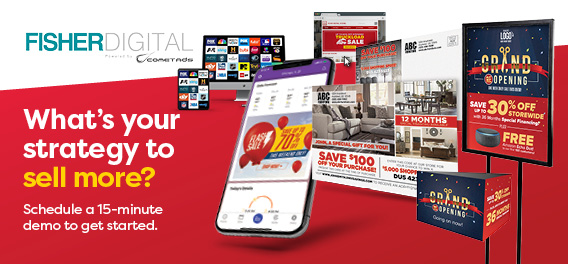Tune-Up Tips: App Edition
April 01, 2019(Editor’s note: This is part of a monthly series about tuning up different aspects of marketing activities.)
“In today’s modern world, people are either asleep or connected.”
-Janice H. Reinold, Rosetta Marketing strategist
Apps are an app-solutely essential component of a modern digital marketing strategy. Why? The overwhelming majority of consumers are glued to their smartphones, making apps THE channel to leverage for communication and marketing.
We provide 5 tips to help marketers tune-up how they utilize apps as well share a mini-dive into how consumers are using the apps on their smartphones in this article.
Tune-Up Tip #1: Leverage apps to promote flash sales
Mobile fueled flash sales and shopping events reached record levels in 2018. U.S. consumers spent a cumulative 130 million hours on Android devices between Black Friday and Cyber Monday, which is a 20% increase from 2017. Consumers spent $5 billion on mobile on Thanksgiving, Black Friday and Cyber Monday.
Don’t forget to include your app the next time your store runs a flash sale or special sales event! Some of the ways you can use your app to promote it include:
• Send a push notification
• Publish content about it on your app
• Share coupons to deepen the sale
• Run the sale exclusively on your app
Tune-Up Tip #2: Optimize social media content for viewing on mobile
Consumers spent half of their time on mobile using apps in the social and communications category globally. In the U.S., time spent in social and communication apps increased 30% compared to 2016.
These are the top 5 most-used social media apps in the U.S. (in order from most-used to least):
1) Snapchat
2) Facebook
3) Instagram
4) Facebook Messenger
5) Pinterest
When planning your social media content, keep mobile users in mind. Make sure graphics/photos look good on a mobile device. Keep copy short and attention-grabbing.
Tune-Up Tip #3: Make your app commerce-friendly
Mobile has now taken over wallet share of U.S. consumers. There was a strong correlation between mobile engagement and mobile commerce. Many U.S. retailers used their apps to make loyalty programs, point-of-sale payments and product information easily accessible.
Mobile wallets account for 30% of mobile’s growth globally and sites with mobile wallets get twice the mobile conversion rate growth. 83% of all shoppers between ages 18-44 use their mobile phones to shop.
There was 70% of growth in the number of shopping sessions in the U.S. in 2018, which is the digital equivalent of foot traffic at a brick-and-mortar store.
Leverage your app to facilitate sales, both in-app and in-store.
Tune-Up Tip #4: Plan with Gen Z in mind
Gen Z (ages 16 to 24) tend to be the most prolific app users among the different age groups who use smartphones.
They had a 30% higher engagement rate in non-gaming apps compared to older demographics and spent20% more time on their favorite apps in 2018.
This segment of the U.S. population commands $29 to $143 in direct spending power. And even though not all Gen Z-ers have an income of their own, they do influence 93% of all household spending, making Gen Z an important demographic to market to. (For more information about Gen Z, check out our What You Should Know About Gen Z blog.)
Tune-Up Tip #5: Measure metrics
“In God we trust—all others must bring data.”
-W. Edwards Deming, statistician and manufacturing guru
How much value is your app providing to your customers and your business? The only way to know is to track analytics. While there are several different metrics you can track, we will list out our top 5 metrics to measure here:
1) Number of Installs
what is it: how many users put the app on their smartphones
where to get it: Google Analytics (here’s a guide on how to set that up)
2) App Acquisition
what is it: where users downloaded the app
where to get it: Google Analytics
3) Average # of Daily Sessions per Active User
what is it: how many times users open and engage with the app daily
where to get it: divide the number of daily sessions by the number of daily average users (get these numbers from Google Analytics)
4) Average Session Length
what is it: how much the average user spends using your app in a single session (here’s a guide on how to set that up)
where to get it: Google Analytics
5) Number of Push Notifications Opened
what is it: how many people read push notifications
where to get it: the service you use to send push notifications
*A note on push notifications: Push notifications stay on the Android’s lock screen until a user dismisses them whereas notifications on iPhones disappear when a user unlocks the phone. That means Android users will likely have higher open rates than iPhone users (in other words, the data will skew in favor of Android users). However, it’s still helpful to know which push notifications users read.
Look for more tips about metrics in our upcoming Tune-Up Tips: Analytics Edition in September.
Mini-Dive: App Overview
We will examine just how connected consumers really are to their mobile phones. We cover how many consumers use apps on their smartphones, usage trends and the top activities consumers use their apps for in this mini-dive.
Prevalence
It is rare to find a U.S. consumer who is not using a smartphone or an app.
A total of 77% of U.S. adults own a smartphone, which is more than double the 35% who did in 2011. For every minute consumers spend surfing the web on their smartphones, they spend 6 minutes in an app.
Marketers are using mobile apps with increasing frequency as part of their marketing efforts. 54% of marketers used mobile apps to market to customers in 2018 and 35% of marketers plan to use mobile apps to market to customers within the next year.
Usage
Consumers are glued to their smartphones.
90% of smartphone owners check their phone within 1 hour of waking up and most check their phones 42-86 times per day.
The amount of time sent in apps grew 50% from 2016 to 2018. U.S. consumers spent almost 3 hours daily in mobile apps in 2018.
Apps are prevalent among audiences of almost every age. How much of each generation uses mobile apps?
• 72% Baby Boomers
• 82% Gen X
• 90% Millennials and Gen Z
Apps are a viable channel for communication as well as marketing-80% of consumers prefer to use mobile apps to communicate with companies. Mobile apps were ranked as the 4th most preferred communication channel (email, in-person and phone made the top 3).
Which apps do consumers like the most? The 5 fastest-growing categories include video players/editors, entertainment, photography, tools and finance.
Activities
Now that we know that the typical U.S. consumer spends a little over one-tenth of their days using apps on their smartphones, we should know their favorite activities and apps to use.
Smartphone activities ranked in order of prevalence:
1) Shopping
2) Getting News
3) Listening to Music
4) Streaming Movies
The top apps (ranked from most to least) in the U.S.:
1) Facebook
2) Facebook Messenger
3) Amazon
4) Instagram
5) Snapchat
6) Netflix
7) Pinterest
8) Pandora Music
9) Twitter
10) Spotify
Editor’s note: This is another entry in our monthly Tune-Up Tips series. Look for our next Tune-Up Tips: Websites Edition on May 13, 2019.
Read the previous entries in our Tune-Up Series:

